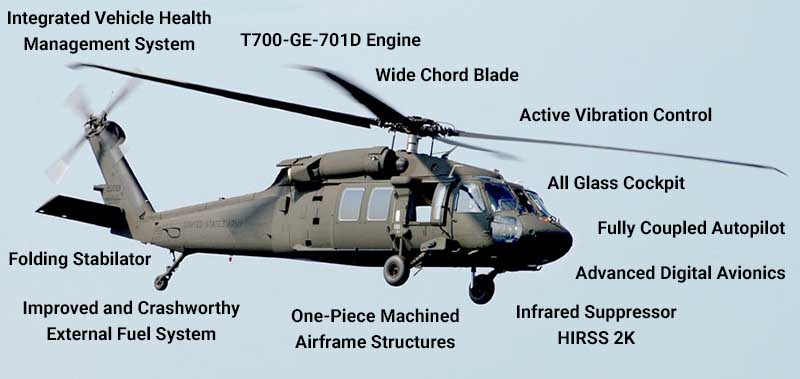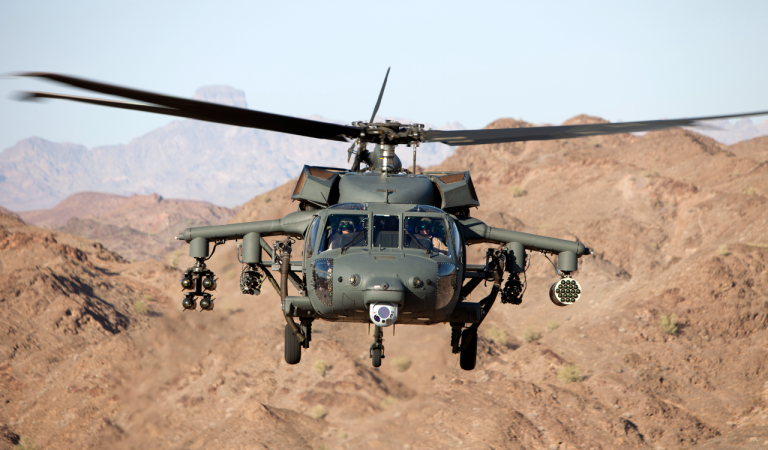The Importance of the UH 60 in Military Procedures and Calamity Alleviation Initiatives
The Importance of the UH 60 in Military Procedures and Calamity Alleviation Initiatives
Blog Article
UH-60: Technologies in Modern Helicopter Layout
The UH-60 helicopter stands as a standard in modern-day aeronautics, showcasing substantial improvements in style and technology that deal with the evolving demands of armed forces procedures. Its incorporation of sophisticated products not only boosts efficiency however additionally addresses vital safety and security problems. The assimilation of sophisticated avionics has transformed functional abilities, allowing for higher situational recognition and decision-making effectiveness. As we check out the advancement and key advancements of the UH-60, it ends up being vital to take into consideration exactly how these developments affect not only existing applications however also the future landscape of helicopter layout.

Evolution of the UH-60
The evolution of the UH-60 Black Hawk helicopter stands for a considerable turning point in aerospace engineering and military air travel. Presented in the late 1970s, the UH-60 was made by Sikorsky Aircraft to satisfy the USA Army's demand for a versatile energy helicopter efficient in performing a range of goals. Its layout stressed speed, maneuverability, and durability, establishing brand-new criteria for operational performance.
The UH-60 includes a distinctive four-blade rotor system, which enhances lift and security, permitting it to run effectively in varied settings. Its airframe is built from sophisticated composite materials, adding to a reduction in weight while maintaining architectural integrity. The helicopter's design also integrates enhanced aerodynamics, which boosts fuel effectiveness and boosts variety.
Over the years, the Black Hawk has actually gone through numerous upgrades to boost its capacities, consisting of improved engines, progressed flight control systems, and modular systems for very easy upkeep and versatility. The helicopter's capability to perform goals varying from army transportation to medical evacuation has actually solidified its role as a foundation of U.S. armed forces procedures. The UH-60 Black Hawk remains a prime example of exactly how technology in helicopter design can substantially affect military performance and operational adaptability.
Advanced Avionics Systems
Developments in avionics systems have changed the abilities of modern helicopters like the UH-60 Black Hawk, improving operational effectiveness and situational recognition (UH 60). The integration of innovative avionics permits enhanced navigating, flight, and communication monitoring, making the UH-60 more flexible in diverse mission profiles
One of the key attributes is the advanced digital cockpit, which utilizes multifunction screens that give real-time data, making certain pilots have prompt access to crucial trip information. This streamlining of info reduces pilot work and improves decision-making processes throughout facility procedures. In addition, the unification of general practitioner and inertial navigation systems makes it possible for specific positioning and path planning, improving goal execution in challenging settings.
In addition, progressed avionics systems improve communication capacities via secure data web links and voice communication systems, allowing seamless sychronisation with ground pressures and various other airplane. The integration of automated trip control systems even more adds to boosted stability and control, especially in negative weather or throughout low-altitude maneuvers.
Engine and Efficiency Enhancements
Engine efficiency in contemporary helicopters has taken a significant leap onward, driven by developments that enhance performance, dependability, and power. The UH-60 Black Hawk, for instance, utilizes the T700-GE-701C engine, which includes a dual-channel, full-authority digital YOURURL.com engine control system.
Additionally, the integration of engine health monitoring systems permits real-time diagnostics and predictive maintenance, considerably enhancing operational integrity. These systems not only sharp crews to potential problems prior to they come to be critical however also facilitate more effective upkeep organizing, thereby minimizing downtime.

Materials and Structural Innovations
Recent advancements in products and structural style have actually reinvented modern helicopter construction, enhancing both efficiency and longevity. The introduction of innovative composite products, such as carbon fiber enhanced polymers, has actually significantly minimized weight while preserving architectural integrity. This change not only boosts gas effectiveness however additionally increases haul capability, allowing helicopters like the UH-60 to carry out more diverse missions.
In addition, advancements in aluminum alloys and titanium components have added to enhanced resistance to deterioration and fatigue, expanding the life expectancy of vital airframe aspects. The critical use these products has actually caused a decrease in upkeep requirements and improved total operational readiness.

Additionally, the assimilation of computer-aided design (CAD) and additive production technologies has actually made it possible for much more lightweight structures visit here and complicated geometries, optimizing the aerodynamic performance of helicopter styles. These advancements help with fast prototyping and production, permitting manufacturers to respond promptly to evolving goal requirements.
Safety And Security and Survivability Functions
Safety and survivability functions in contemporary helicopter layout have actually come to be critical, mirroring the boosting needs for mission efficiency in difficult environments. The UH-60 Black Hawk, a notable example, incorporates sophisticated innovations to boost crew and guest security. One of the most essential developments is the consolidation of crashworthy fuel systems created to lessen the threat of fire during impact. Furthermore, the airframe is constructed with strengthened products that dissipate and soak up power, additional safeguarding residents in case of a crash.
The helicopter additionally utilizes a ballistic defense system, which consists of armored staff seats and important systems shielding, minimizing susceptability to tiny arms fire and shrapnel. Improved situational understanding is attained through sophisticated avionics and sensor modern technologies, allowing pilots to spot and stay clear of dangers efficiently.
Moreover, website here the assimilation of redundancy in vital systems-- such as twin engines and multiple flight control networks-- makes sure ongoing operation also if one system fails. The UH-60 is equipped with advanced emergency situation flotation protection tools, improving survivability in water touchdowns. Collectively, these functions not just enhance the safety of workers yet additionally boost goal success prices in hostile atmospheres, showing the dedication to quality in helicopter design.
Verdict
The UH-60 helicopter represents a considerable innovation in contemporary air travel modern technology, integrating cutting-edge materials, innovative avionics, and durable safety and security features. Its development reflects a dedication to enhancing efficiency and functional efficiency while making sure pilot and team survivability. The integration of light-weight compounds and progressed navigation systems emphasizes the helicopter's adaptability in different army missions. On the whole, the UH-60 works as a criteria for future developments in helicopter style, personifying strength and adaptability in contemporary military operations.
The UH-60 helicopter stands as a benchmark in modern aeronautics, showcasing significant advancements in style and technology that provide to the evolving needs of military operations. As we explore the development and essential advancements of the UH-60, it comes to be vital to think about just how these developments affect not only present applications however likewise the future landscape of helicopter layout.
Introduced in the late 1970s, the UH-60 was developed by Sikorsky Airplane to meet the United States Army's demand for a versatile energy helicopter capable of carrying out a variety of missions. The UH-60 Black Hawk remains a prime example of how advancement in helicopter style can substantially influence military efficiency and functional adaptability.
On the whole, the UH-60 serves as a criteria for future developments in helicopter style, personifying strength and adaptability in modern army procedures.
Report this page